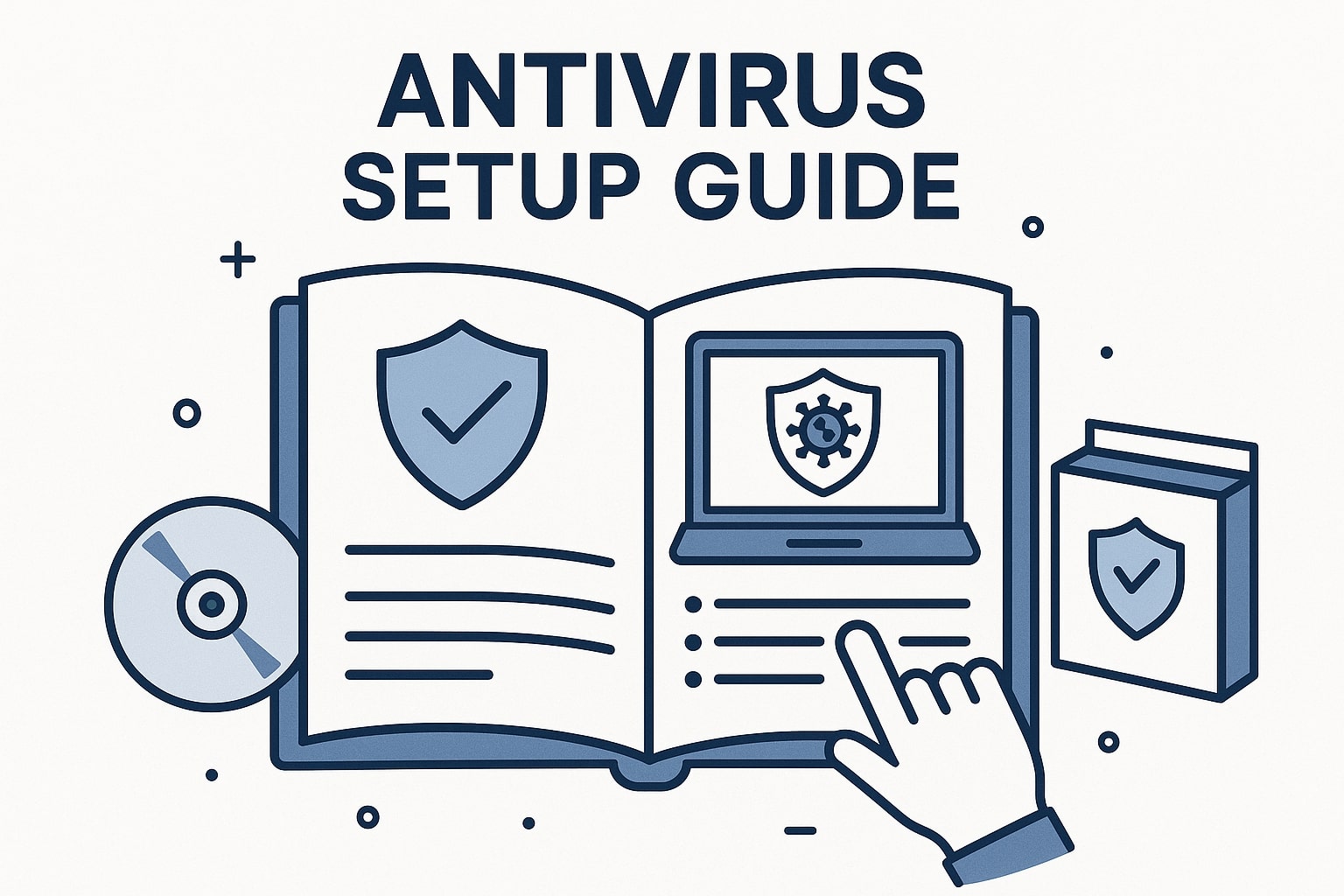As cyber threats rapidly evolve, smart protection is no longer optional—it’s essential. Modern attackers are now leveraging artificial intelligence to create highly adaptive malware capable of bypassing traditional security tools. In this Antivirus Setup Guide, Protech Advisor walks you through the advanced steps needed to secure your devices, networks, and data from AI-powered threats. By following the right setup process and deploying robust security configurations, you can significantly reduce your vulnerability to next-generation cyberattacks.
Understanding the Rise of AI-Powered Malware
AI-driven malware represents a dangerous shift in cybersecurity. Unlike conventional viruses that follow fixed patterns, AI malware learns from system behavior, adjusts automatically, and hides itself more effectively. It can mutate faster than legacy antivirus programs can detect it, making it essential for users to upgrade their approach to antivirus setup and security hardening.
Cybercriminals now deploy AI bots to:
-
Bypass heuristic detection.
-
Mimic legitimate processes.
-
Analyze your system configuration in real-time.
-
Launch targeted attacks based on prediction models.
This is why a traditional setup is no longer sufficient. You need an antivirus system equipped with machine-learning detection, behavioral scanning, and cloud-based intelligence to keep up.
Why an Advanced Antivirus Setup Matters Today
A simple installation is not enough anymore. If your antivirus settings aren’t configured properly, AI malware can still slip past and compromise your system. An optimized antivirus setup ensures:
-
Real-time scanning at maximum efficiency
-
Advanced threat detection for polymorphic malware
-
Firewall integration to block suspicious outbound connections
-
System-level monitoring for abnormal behavior
-
Zero-day attack protection via cloud updates
When configured properly, your antivirus becomes a 24/7 shield that adapts and responds to threats instantly.
Choosing the Right Antivirus for AI Malware Protection
To fight AI with AI, you need a security solution that integrates machine learning, behavioral analytics, and real-time intelligence. When selecting an antivirus, look for:
1. AI and Machine-Learning Detection
Your antivirus should be able to detect anomalies, not just signature-based threats. AI detection allows your system to identify suspicious behavior even when the malware is brand new.
2. Behavioral Scanning Engine
This technology monitors program activity and flags anything that behaves unusually, such as unauthorized encryption or hidden process execution.
3. Cloud Threat Intelligence
Cloud updates ensure your antivirus database is always current—critical for fighting fast-mutating AI malware.
4. Ransomware Rollback Features
AI malware often encrypts files instantly. Rollback features restore previous versions and minimize damage.
5. Multi-Device Protection
With attackers targeting smartphones and IoT devices, choose an antivirus that secures all your platforms.
Step-By-Step Antivirus Setup Guide for Maximum Protection
Below is a comprehensive setup process to strengthen your defense against AI-driven threats.
Step 1: Download Your Antivirus from a Trusted Source
Never download antivirus software from third-party sites. Only use the official website to avoid counterfeit installers that may carry malware. Once the download starts, ensure your network connection is stable to avoid file corruption.
Step 2: Run the Installer and Choose Custom Setup
Most users select the default installation option, but custom setup gives more control. This allows you to:
-
Select full installation components.
-
Set preferred directories.
-
Enable security modules such as ransomware protection, browser safety, or email scanning.
Choosing custom installation ensures you activate essential features from the start.
Step 3: Perform an Initial Full System Scan
Once installed, perform a full scan immediately. This detects existing threats that might interfere with the antivirus setup. AI malware sometimes disables security tools during installation, so catching it early is crucial.
Expect the first scan to take longer, as it builds initial memory patterns for behavioral analysis.
Step 4: Enable Real-Time Protection
Real-time protection is your frontline defense, constantly monitoring every file, process, and download. Ensure the following are switched ON:
-
Web protection
-
Email scanning
-
Download analysis
-
Script blocking
-
Behavior monitoring
Without real-time scanning, AI malware can infect your system instantly—even before a scheduled scan occurs.
Step 5: Activate Cloud-Based Machine Learning Filters
Most modern antivirus programs include cloud-powered malware detection. Turn on:
-
Cloud scanning
-
AI-based threat engines
-
Online behavior prediction modules
These features help your antivirus stay updated against the latest AI-driven attack patterns.
Step 6: Configure Your Firewall for AI Threat Blocking
AI malware often communicates with command-and-control servers. Configure your firewall to:
-
Block unknown outbound connections
-
Alert you when apps modify network access
-
Restrict scripts or macros from connecting to external servers
A strong firewall setup cuts malware’s communication lifeline.
Step 7: Schedule Automatic Updates and Scans
AI threats evolve rapidly. Automatic updates ensure your antivirus is ready for new malware variants. Schedule:
-
Daily quick scans
-
Weekly deep scans
-
Hourly cloud updates (if available)
Consistency is key to maintaining maximum protection.
Step 8: Enable Browser and Email Protection
Malicious AI bots often use phishing, drive-by downloads, and fake web sessions to infiltrate your device. Activate:
-
Anti-phishing filters
-
Unsafe website warnings
-
Email attachment scanning
-
Script blocking in browsers
This minimizes the risk of human error leading to infection.
Step 9: Set Up Ransomware Protection and Folder Shielding
Modern AI ransomware is extremely fast. Enable:
-
Ransomware shield
-
Folder protection for sensitive data
-
Backup sync (local or cloud)
This helps secure personal and business information from instant encryption.
Step 10: Monitor Activity Logs and Alerts
Your antivirus generates activity logs that track malware attempts, blocked connections, and unusual processes. Review logs weekly to identify recurring threats or suspicious behavior patterns.
Advanced Antivirus Configuration Tips for AI Malware Defense
While the basic setup is essential, taking a few advanced steps can significantly strengthen your system against AI-driven threats. Cyber attackers constantly modify malware to slip past predictable configurations. These advanced settings help you stay ahead of evolving digital dangers.
1. Enable Intrusion Detection and Prevention Systems (IDS/IPS)
Modern antivirus solutions often include IDS/IPS modules that act as surveillance systems for your network. By monitoring incoming and outgoing data packets, these tools detect unusual patterns often associated with AI malware.
Enable the following:
-
Signature-based intrusion detection
-
Anomaly-based intrusion detection
-
Real-time intrusion prevention
Anomaly-based systems are particularly effective against AI malware because they look for odd behaviors, even from seemingly legitimate processes.
2. Configure Sandboxing for Suspicious Applications
Sandboxing isolates unknown files or applications in a controlled, virtual environment. Instead of blocking every new file, sandboxing lets the antivirus test the file’s behavior safely.
When configuring sandboxing:
-
Ensure unknown EXE and ZIP files open inside the sandbox
-
Enable automatic sandbox for unsigned applications
-
Set executable restrictions for external devices
If the file behaves suspiciously — such as modifying system registries or triggering hidden scripts — the antivirus blocks it before any damage occurs.
3. Activate USB and External Device Scanning
AI malware frequently spreads through removable devices. Attackers program malware to auto-execute once the device is plugged in.
Strong antivirus setup includes:
-
Automatic USB scanning
-
Blocking autorun.inf execution
-
Device access notifications
-
Encryption for sensitive external drives
This prevents AI-powered threats from infiltrating your system via offline vectors.
4. Strengthen Your Email Security Setup
Email remains the most common entry point for malware. Deep-learning phishing attacks use AI to craft realistic messages that mimic trusted organizations.
To strengthen email protection:
-
Enable attachment sandboxing
-
Turn on link scanning to analyze URLs before they open
-
Activate spoofing protection
-
Configure filters to identify AI-generated patterns
These small setup adjustments help eliminate up to 90% of social-engineering-based infections.
5. Use Multi-Layered Security (Defense-in-Depth)
Relying on a single antivirus tool is no longer enough. Multi-layered security ensures that if one layer misses a threat, another catches it.
Recommended layers include:
-
Antivirus
-
Anti-malware
-
Firewall
-
Browser protection
-
Email filters
-
Network monitoring
-
Data backup system
AI malware works fast, but multi-layered defense slows it down at every stage of execution.
6. Enable Dark Web Monitoring (If Provided)
Some premium antivirus solutions now include dark web scanning to detect leaked passwords, credentials, or personal data. Since AI cyber tools harvest data faster than ever, this feature helps you react before attackers gain access.
Enable alerts for:
-
Exposed email IDs
-
Compromised passwords
-
Username leaks
-
Credit card monitoring
Immediate notification ensures you take action before attackers exploit your information.
7. Restrict App Permissions and Background Activities
AI malware often hides inside legitimate-looking apps and silently runs in the background. Restricting app permissions drastically reduces this risk.
Configure the following:
-
Block background execution for unknown apps
-
Disable unnecessary system permissions
-
Turn off developer mode (important for Windows & Android)
-
Restrict admin rights to essential apps only
When apps operate with fewer privileges, malware inside them gains less control.
8. Optimize System Settings for Stronger Protection
Some system-level changes further enhance your antivirus’s effectiveness.
Recommended settings:
-
Disable remote access unless required
-
Turn off unnecessary network ports
-
Enable secure boot
-
Enforce strong password policies
-
Keep OS and drivers always updated
These settings prevent malware from exploiting outdated or vulnerable system components.
9. Educate Users on AI Malware Risks
Even with the strongest antivirus setup, human error remains a major vulnerability. AI-driven phishing and social-engineering attacks are incredibly convincing.
Train users to:
-
Avoid clicking unknown links
-
Not download unsolicited attachments
-
Double-check email sender addresses
-
Use unique passwords for each platform
-
Verify website authenticity before entering credentials
Cybersecurity starts with awareness.
10. Regularly Back Up Important Data
In the age of AI ransomware, backups are your last line of defense. Even when malware bypasses your antivirus, you can restore your system without losing essential files.
Best backup practices include:
-
Use both local and cloud backups
-
Enable automated daily backups
-
Encrypt sensitive files
-
Store backup drives offline when possible
If AI ransomware strikes, you can recover quickly without paying attackers.
Protech Advisor’s Final Recommendations for Long-Term Security
AI-powered threats will continue evolving, and cybersecurity must adapt continuously. The key is maintaining a proactive, layered, and intelligent security strategy rather than a reactive one.
Protech Advisor recommends:
-
Always use an AI-enhanced antivirus
-
Regularly check your security settings
-
Keep every device updated
-
Avoid installing unknown applications
-
Monitor unusual behaviors or device slowdowns
By combining strong antivirus configuration with smart cyber hygiene, you substantially reduce your risk of AI-based attacks.
Your digital safety ultimately relies on active vigilance, consistent updates, and secure antivirus setup practices. The stronger your first line of defense, the harder it becomes for attackers to penetrate your system and compromise data. Make every device you use resilient with proper Antivirus Installation.
Final Thoughts: Stay Ahead of AI-Driven Threats
AI malware is becoming more sophisticated, but with a powerful antivirus setup and proactive security configuration, users can stay one step ahead of attackers. Regular updates, real-time monitoring, and behavior-based protection are essential in today’s digital environment. By implementing the strategies in this guide, you can secure your data, devices, and privacy more effectively. Protecting your system starts with strong Antivirus Installation.








Leave a Reply